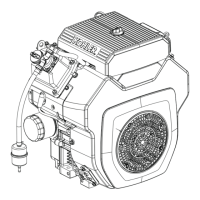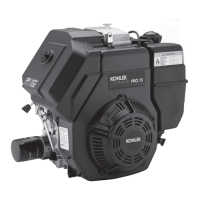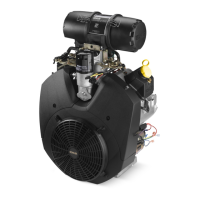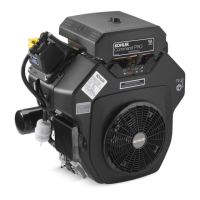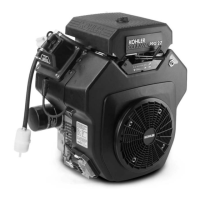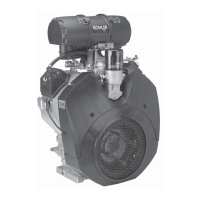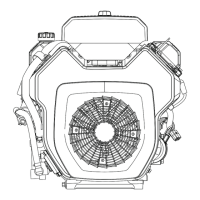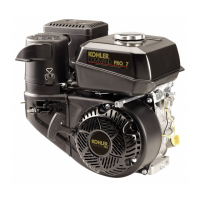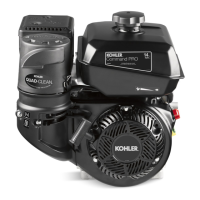10.2
Section 10
Internal Components
Inspect the crankshaft keyways. If worn or chipped,
replacement of the crankshaft will be necessary.
Inspect the crankpin for score marks or metallic
pickup. Slight score marks can be cleaned with crocus
cloth soaked in oil. If wear limits, as stated in
“Specifications and Tolerances” are exceeded, it will
be necessary to either replace the crankshaft or regrind
the crankpin to 0.25 mm (0.010 in.) undersize. If
reground, a 0.25 mm (0.010 in.) undersize connecting
rod (big end) must then be used to achieve proper
running clearance. Measure the crankpin for size,
taper, and out-of-round.
Crankcase
Inspection and Service
Check all gasket surfaces to make sure they are free of
gasket fragments. Gasket surfaces must also be free of
deep scratches or nicks.
Check the cylinder bore wall for scoring. In severe
cases, unburned fuel can cause scuffing and scoring of
the cylinder wall, washing the necessary lubricating
oils off the piston and cylinder wall. As raw fuel seeps
down the cylinder wall, the piston rings make metal to
metal contact with the wall. Scoring of the cylinder
wall can also be caused by localized hot spots
resulting from blocking cooling fins or from
inadequate or contaminated lubrication.
If the cylinder bore is badly scored, excessively worn,
tapered, or out of round, resizing is necessary. Use an
inside micrometer to determine amount of wear (refer
to the “Specifications, Tolerances, and Special Torque
Values”, in Section 1), then select the nearest suitable
oversize of either 0.25 mm (0.010 in.) or 0.50 mm
(0.020 in.). Resizing to one of these oversizes will
allow usage of the available oversize piston and ring
assemblies. Initially, resize using a boring bar, then use
the following procedures for honing the cylinder.
Honing
While most commercially available cylinder hones can
be used with either portable drills or drill presses, the
use of a low speed drill press is preferred as it
facilitates more accurate alignment of the bore in
relation to the crankshaft crossbore. Honing is best
accomplished at a drill speed of about 250 RPM and
60 strokes per minute. After installing coarse stones in
hone, proceed as follows:
1. Lower hone into bore and after centering, adjust
so that the stones are in contact with the cylinder
wall. Use of a commercial cutting-cooling agent is
recommended.
2. With the lower edge of each stone positioned
even with the lowest edge of the bore, start drill
and honing process. Move the hone up and down
while resizing to prevent the formation of cutting
ridges. Check the size frequently.
NOTE: Measure the piston diameter and resize
the bore to the piston to obtain the
specified running clearances. Keep in
mind the temperatures caused by honing
may cause inaccurate measurements.
Make sure the bore is cool when
measuring.
3. When the bore is within 0.064 mm (0.0025 in.) of
desired size, remove the coarse stones and
replace with burnishing stones. Continue with
the burnishing stones until within 0.013 mm
(0.0005 in.) of desired size and then use finish
stones (220-280 grit) and polish to final size. A
crosshatch should be observed if honing is done
correctly. The crosshatch should intersect at
approximately 23-33° off the horizontal. Too flat
of an angle could cause the rings to skip and wear
excessively, too steep of an angle will result in
high oil consumption (refer to Figure 10-1).
Figure 10-1. Cylinder Bore Crosshatch after
Honing.
4. After resizing, check the bore for roundness,
taper, and size. Use an inside micrometer,
telescoping gauge, or bore gauge to take
measurements. The measurements should be
taken at three locations in the cylinder - at the top,
middle, and bottom. Two measurements should
be taken perpendicular to each other) at each of
the three locations.
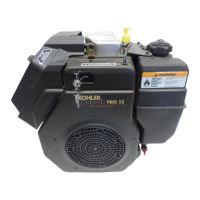
